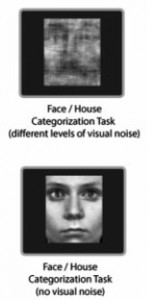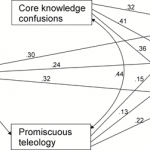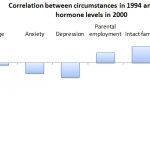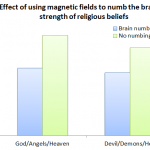Humans are finely honed for spotting intentional agents in our environment. Meaning that if you hear a rustling, or see a branch move, you’re instantly on the alert in case it is another person (this effect is has a name: ‘hyperactive agency detection’).
You can see why evolution would have favoured that. Better safe than sorry, right? The result is that it’s not uncommon to see humans when there’s nothing really there. Ghosts, anyone?
But not all humans are equally sensitive to that effect. Even more intriguingly, there’s good evidence that you can manipulate the sensitivity – for example by making people feel they are not in control of events.
Michiel van Elk (University of Amsterdam) previously found that paranormal believers were more prone to see human figures walking in a random cloud of dots. In his latest set of studies, he wanted to know whether subliminal primes about the supernatural can make people prone to this illusion.
First he ran a couple of studies on local students using a similar moving dots task.There were lots of different patterns – some clearly figures walking, some just dots, but most were somewhere between the two. They had to say whether or not they saw a figure walking.
Before viewing the dots, they were shown a word that either had supernatural connotations (god, ghost, spirit, ghoul, etc), or was an animal or human (lawyer, clown, dentist etc).
There was no detectable effect of these different words on what they saw. The students were no more likely to imagine they had seen a figure walking if they had thoughts of the supernatural implanted in their minds.
 Then he ran three studies that were similar in set-up but where the subjects had to decide if a picture showed a human face or a house – with varying degrees of blurriness. The first two were similar to the earlier studies, but the third ramped things up a bit by asking the subjects to think harder about the supernatural or human beings by asking to describe their traits).
Then he ran three studies that were similar in set-up but where the subjects had to decide if a picture showed a human face or a house – with varying degrees of blurriness. The first two were similar to the earlier studies, but the third ramped things up a bit by asking the subjects to think harder about the supernatural or human beings by asking to describe their traits).
Still no effect.
On the face of it, this shows fairly clearly that simply priming people to think about the supernatural does not lead them to see human figures in noisy images. It does not pump up their hyperactive agency detection.
There was a wrinkle. Some of the subjects were religious, and in three of the five studies people who were more religious on at least one measure of religiousness (e.g. how strongly they believe, or how often they went to church) were more likely to see ghosts after seeing the supernatural prime.
Except. Well, the following is a big ‘except’ that is a fairly common problem with psychology studies, and it goes by the name of multiple comparison testing.
When the researchers put all the data from all the studies together, there was no effect of religion. That’s because in some studies the believers, but not the churchgoers, showed the effect. In others, it was the other way round.
So what we’re seeing here is probably just blind chance at work. If you cut the data up enough and look at it in enough different ways, your bound to find something that looks unusual (or is ‘significant’, in scientific parlance).
Interestingly enough, the human primes (lawyer, clown…) did trigger this hyperactive agency detection. So we know the experimental method works.
It’s just that simply thinking about ghosts is not enough to make you see them. Ghosts stories, on the other hand…
van Elk, M., Rutjens, B., van der Pligt, J., & van Harreveld, F. (2014). Priming of supernatural agent concepts and agency detection Religion, Brain & Behavior, 1-30 DOI: 10.1080/2153599X.2014.933444
 This article by Tom Rees was first published on Epiphenom. It is licensed under Creative Commons.
This article by Tom Rees was first published on Epiphenom. It is licensed under Creative Commons.











